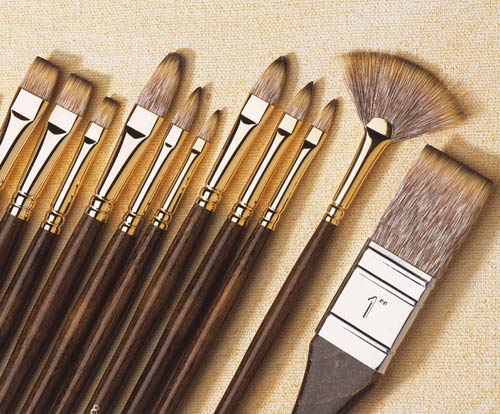Oil Brushes
More in this Section: |
- Artisan Water Mixable Oil Brushes |
Choosing the right brush is important and at Winsor & Newton, they have 150 years of brush making experience which has allowed them to create a number of brushes that are ideal for oil colour painting.
When choosing a brush to use for oil colour, you need to think about a brush with hair that is able to move thick, viscous colour e.g. Hog hair. However, if you plan to use thinners to alter the properties of the colour you will then need to consider using another type of hair e.g. Sable hair.
How to Choose an Oil Brush
 There is one main benchmark for brushes that are used with thick or viscous colour; the thicker the colour, the stiffer the brush needs to be. A heavy paint like oil requires a brush with enough resilience to manipulate the colour with complete control.
There is one main benchmark for brushes that are used with thick or viscous colour; the thicker the colour, the stiffer the brush needs to be. A heavy paint like oil requires a brush with enough resilience to manipulate the colour with complete control.
However, a colour that has been thinned will need softer tuft (e.g. soft hair or filament) and a colour that has been thinned to a fluid consistency needs a brush with flow control (e.g. synthetic or natural hair brush such as sable).
Therefore brush characteristics to consider are:
Firmness of bristle – Is the bristle capable of moving heavy-bodied colour over the surface with authority?
Tip control – Does the bristle or hair allow for subtlety in blending? Does it give fine control when creating detail?
Oil colour brushes are generally made from two different types of hair, Hog and Synthetic hair.
Hog
Properly dressed, the finest quality hog brushes offer superior firmness and flagged ends for control and blending. Hog bristle is good for use with thick colour. The hair is extremely resilient and the most important characteristic is that it is ‘flagged’ or split at the end.
These flags carry more colour on the brush and apply it evenly on the surface. The very best hog brushes have over 80% flagged hairs. We offer three types of hog hair brushes (Artists’ Hog, Winton and Azanta) and one synthetic brush which resembles the properties of Hog (Artisan).
Sable
The second choice for oil colour painters is a sable brush. These are used when the painter needs more control of colour when it has been thinned down with solvents. The high quality hair gives the brush excellent shape retention and allows the artists to paint intricate detail. This makes it the ideal complement to a Hog brush in an oil painter's studio.
Synthetic
High quality synthetic fibres are especially good if the brushes come into contact with water. As with our Artisan Water Mixable Oil Colours, where the brushes can be cleaned with water it is important that the brushes remain strong and durable and appropriate for painting with thick bodied colour straight from the tube.
However sometimes when oil colour has been thinned it is necessary to have a softer tuft. This is where synthetic fibres also work well. For example with the Synthetic Mongoose hair used in our Monarch brushes, providing a balance between the stiffness of hog and the softness of sable.
Care & Cleaning
Care of Oil Brushes
To ensure the best possible performance and longest life for your hog brushes follow these simple rules:
Always clean brushes immediately after use (see below).
Never leave brushes resting on their bristles.
Shape up bristles with your fingers after cleaning.
If you are storing hog brushes for any length of time, make sure they are clean and perfectly dry and keep them in a box with a tight fitting lid to avoid moth damage. If the brushes are not absolutely dry they may develop mildew.
Paint should never be allowed to dry on any brush. Should this happen household paint stripper could be used to soften it, however the brush is unlikely to return to its original shape afterwards.
Cleaning of Oil Brushes
Wipe excess colour from the brush using a rag.
Rinse remaining colour form brush using Artists’ White Spirit or Sansodor for oils and alkyds, water for Artisan.
Next, clean the bristle with Winsor & Newton Artgel or household soap (not detergent), working up a lather and rinsing the brush under warm (not hot) water. Repeat this until there is no trace of colour. Ensure all traces of soap are removed.
Finally, shape up the brush, dry the handle and rest the brush bristles uppermost in a pot or jar to dry.










